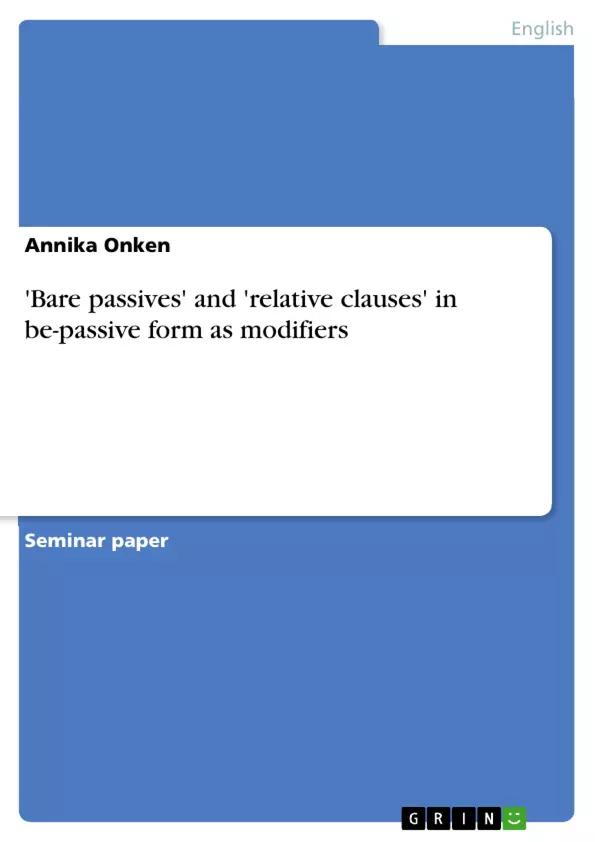1 Introduction
In order to learn more about the English language and how it is actually used by the native speaker community I am going to investigate the occurrence of bare passives as modifiers and of relative clauses in be-passive form which can be compared to the former in its function as modifier. With help of the queries I will find out how many of these constructions exist in The Penn Treebank and then take a closer look at the beginning of sentences. Which of these two grammatical phenomenon is more frequent at the beginnings of sentences and why? Firstly in this term paper, I will introduce the grammatical phenomenon of the passive voice with its variants ‘be-passive’, ‘get-passive’ and ‘bare passive’ by contrasting it to the active voice. Furthermore I will explain the development of the different queries needed for the research whose findings will be discussed subsequent to that.
Inhaltsverzeichnis (Table of Contents)
- Introduction.
- The Grammatical Phenomenon
- Differences between Active and Passive Voice.
- Variations of the Passive Voice.
- Get-Passive.
- Bare-Passive.
- Bare Passives as Complements.
- Bare Passives as Modifier.
- The Development of Queries in the Penn Treebank.
- Be-Passive.
- Get-Passive.
- Bare Passives as Modifier.
- Relative Clauses in Be-Passive Form.
- Research findings.
- Frequency of Be-Passive and Get-Passive.
- Frequency of Bare Passives as Modifiers and Relative Clauses in Be-Passive Form.
- Frequency of Bare Passive as Modifier and Relative Clause in be-passive form at the beginning of sentences.
- Conclusion.
Zielsetzung und Themenschwerpunkte (Objectives and Key Themes)
This term paper examines the occurrence of bare passives as modifiers and relative clauses in be-passive form, comparing their function as modifiers in the English language. Using the Penn Treebank, the research aims to quantify these constructions and analyze their frequency at the beginnings of sentences. The study investigates the prevalence of these grammatical phenomena and seeks to understand why one might be more frequent than the other in this specific context.
- The grammatical phenomenon of passive voice and its variations, including be-passive, get-passive, and bare passive.
- The development of queries for analyzing the frequency of different passive constructions in the Penn Treebank.
- The frequency and distribution of bare passives as modifiers and relative clauses in be-passive form in the Penn Treebank.
- The frequency of these constructions at the beginning of sentences.
- The potential reasons for the observed frequency differences in these constructions at sentence beginnings.
Zusammenfassung der Kapitel (Chapter Summaries)
- Introduction. This chapter introduces the research topic of bare passives as modifiers and relative clauses in be-passive form, outlining the goal of investigating their occurrence in the Penn Treebank and analyzing their frequency at the beginning of sentences.
- The Grammatical Phenomenon. This chapter discusses the differences between active and passive voice, highlighting the concept of voice as a grammatical category that allows different perspectives on the same information without altering its truth value. The chapter examines the structure and function of both active and passive clauses, emphasizing the different roles of agents and affected entities within each construction.
- Variations of the Passive Voice. This chapter explores the different variations of the passive voice, including the be-passive, get-passive, and bare passive. It delves into the grammatical characteristics, stylistic preferences, and semantic implications of each variant, comparing their usage in both formal and informal settings.
- The Development of Queries in the Penn Treebank. This chapter explains the creation of specific queries for the Penn Treebank, tailored to identify the targeted grammatical constructions of bare passives as modifiers and relative clauses in be-passive form. This section provides details on the criteria used to define these constructions and the methods applied for their retrieval from the corpus.
- Research findings. This chapter presents the findings of the research, focusing on the frequency of different passive constructions and their distribution within the Penn Treebank. The chapter analyzes the frequency of bare passives as modifiers and relative clauses in be-passive form, with specific attention to their prevalence at the beginning of sentences.
Schlüsselwörter (Keywords)
This research focuses on the grammatical phenomenon of passive voice, particularly on bare passives as modifiers and relative clauses in be-passive form. The study utilizes the Penn Treebank corpus to analyze the frequency and distribution of these constructions, paying special attention to their prevalence at the beginnings of sentences. Key concepts include active and passive voice, be-passive, get-passive, bare passive, grammatical function, and syntactic analysis.
- Quote paper
- Annika Onken (Author), 2007, 'Bare passives' and 'relative clauses' in be-passive form as modifiers, Munich, GRIN Verlag, https://www.hausarbeiten.de/document/84333


